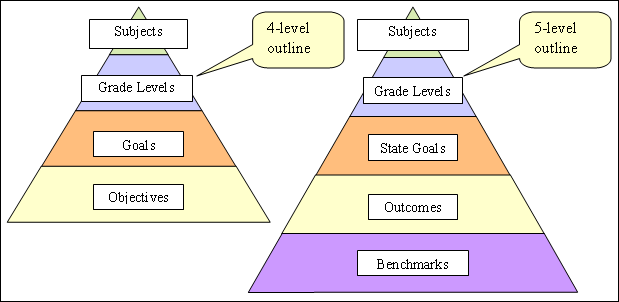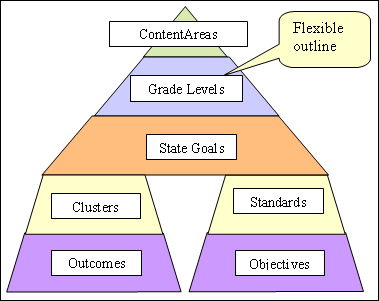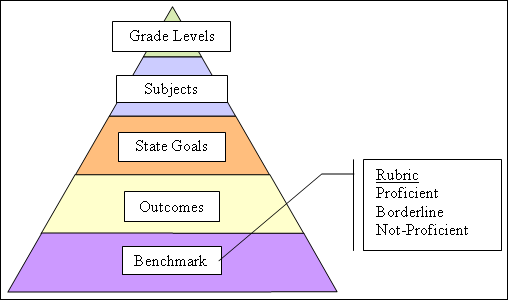Plan the Curriculum Outline
The curriculum outline represents (in the form of a hierarchical outline) the scope and sequence of subject matter that students are expected to master. The outline can be organized into any number of hierarchical levels but is typically four or five levels deep. The labels or terminology associated with these levels is defined by the school district, but typically includes grade level, subject area, standard, outcome, objective, and benchmark. The flexibility inherent in the curriculum outline allows the school district to merge multiple sources of curriculum statements (e.g., state mandates, norm-referenced testing outcomes, local district expectations, etc) into a single curriculum.
Outline the Curriculum Levels
The first step in designing the curriculum outline is to ascertain what the district and community are using as the basis for determining proficiency. The source documents that provide this information are analyzed to determine the most appropriate number of outline levels and the best labels use to describe those levels. 
It is assumed that the same outline levels are applicable for all subject areas in the curriculum. In actuality, it is often the case that there will be some variance in the outline levels from one content area to the next.
Individual outline levels can be mandatory or optional. Optional means that the level is applicable in some parts of the curriculum (i.e., for certain content areas) and not others. Mandatory means this level applies throughout the outline (i.e., all content areas). In the following example, the top three levels are applicable throughout the curriculum outline and are therefore not optional. The lowest two levels in the example below would be optional in the sense that, for some content areas, clusters and outcomes are applicable and for other content areas, standards and objectives are applicable.

Decide Which Outline Level is Used to Measure Proficiency
Once the outline levels are defined, the next step is to decide which of the outline levels will be directly measured to determine the proficiency levels of students. For example, a school district using the flexible outline may decide that clusters, outcomes, standards, and objectives will be directly assessed using a combination of subjective and objective measures.
To support this, a rubric can be set up for the outline level being directly assessed. Setting up the rubric involves identifying and naming the proficiency levels that students can attain. The school district can customize the actual terminology it wishes to use. It is important to note that all student performance data will ultimately be translated into these proficiency levels (or rubrics) when individual, class, and group progress reports are generated by the system.

Define the Curriculum Statements
Once the curriculum outline levels are defined, they can be populated with curriculum statements (i.e., the textual statements describing the specific grade levels, subjects, state goals, etc.) This text can be entered manually, imported from another system, or entered by copying and pasting from a document. By using tags, you can generate listings and progress reports that select only the tags you specify. For example, you can generate a curriculum listing that will only include state-designated outcomes. The school district can define a tag by giving it a name, selecting an icon for it, and associating it with the curriculum statements it applies to.

In the curriculum outline, each curriculum statement is assigned a unique label. This labeling scheme can be customized by the school district. In Figure 1E, each curriculum statement is preceded by its unique label: Grade 4 is labeled 04, Language Arts is labeled 04LA, etc.) Labels from the broader levels of the outline become prefixes in the labels of statements at deeper levels. For example, the label 04LA for Language Arts begins with the label for the curriculum statement above it, namely 04 for Grade 4, and then adds the segment LA for Language Arts. Hence, each label identifies not only the curriculum statement but also its position in the outline.
Once the hierarchical outline has been established, it is relatively straightforward to produce translations into other languages such as French and Spanish.
